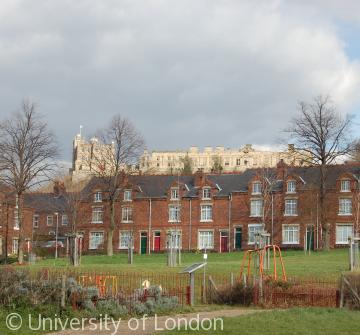Workers Housing
 The mining village of New Bolsover with Bolsover castle above
The mining village of New Bolsover with Bolsover castle aboveThe shift from cottage industry to mills and factories during the Industrial Revolution brought about a shift from manufacturing in towns and villages to industrial production in more remote and rural areas away from existing settlement. The textile industries’ reliance on waterpower to drive spinning, carding and weaving machines and the need of industrialists to protect their technological innovations to maintain an advantage over their rivals, lead to mills being constructed away from centres of population. The same was also true of extractive industries, whose location was determined by mineral deposits.
The provision of housing by industrial entrepreneurs had a number of advantages. It firstly attracted a workforce to the area, but once there allowed the mill or colliery owner to supervise the workers, regulating their behaviour and ensuring they clocked in and out at the correct times. Housing for the workers often took the form of small planned villages of terraced houses, complete with a school and chapel. Early examples include Richard Arkwright’s village at Cromford and the expansion of Belper to accommodate the workers of Jedediah Strutt’s mills.
As mills increased in size during the 19th century, so too did the provision of workers housing both by the industrialists themselves and by speculative builders keen to capitalise on the rents available from a burgeoning workforce. In 1853 the Yorkshire wool industrialist, Sir Titus Salt relocated all five of his mills from Bradford to a new site near to the river Aire and constructed a large village of stone terraced houses which bore his name, Saltaire. Built on a grander scale than any that had gone before, Saltaire included a Congregational Church, bath houses, a hospital, a library and a concert hall.
The construction of model villages was not confined to the textile industry. To house the workers of the Swindon railway works completed in 1842, the Great Western Railway built a model village in Swindon, while on the Derbyshire coalfield, model villages were constructed at Bolsover and Cresswell adjacent to the pit heads.
The provision of housing for the workforce also occurred within established urban centres. During the 19th century rows of brick built terraced houses were constructed in the majority of England’s urban centres including the notorious ‘back to back’ houses, rows of terraces which shared the rear wall with the row behind. Ill-lit, poorly ventilated and with limited provision of sanitation, these houses became synonymous with the worst aspects of Victorian life.






